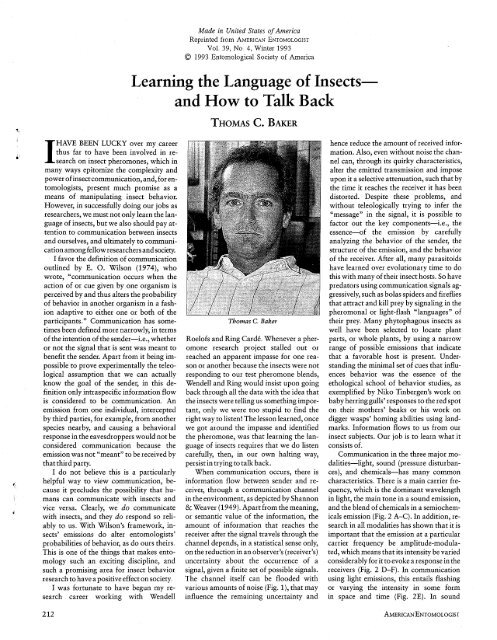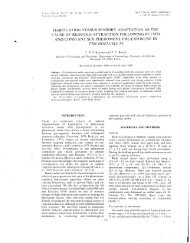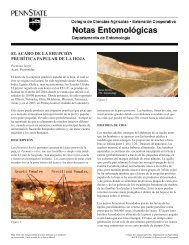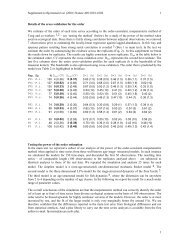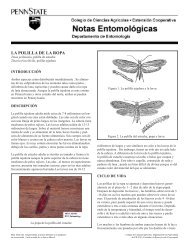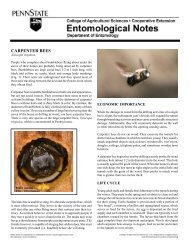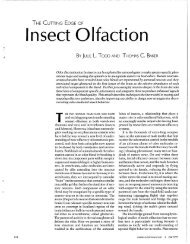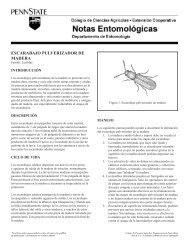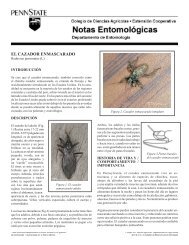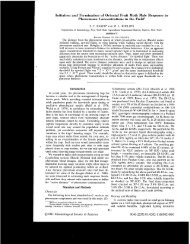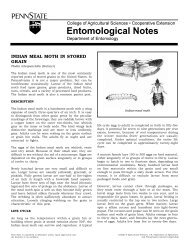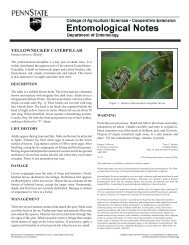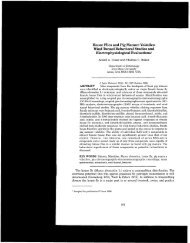Learning the Language of Insects- and How to Talk Back - Entomology
Learning the Language of Insects- and How to Talk Back - Entomology
Learning the Language of Insects- and How to Talk Back - Entomology
You also want an ePaper? Increase the reach of your titles
YUMPU automatically turns print PDFs into web optimized ePapers that Google loves.
Made in United States <strong>of</strong> AmericaRepiinted from AMERICAN ENTOMOLOGISTVol 39, No 4, Wmter 1993@ 1993 En<strong>to</strong>mological Society <strong>of</strong> America<strong>Learning</strong> <strong>the</strong> <strong>Language</strong> <strong>of</strong> <strong>Insects</strong><strong>and</strong><strong>How</strong> <strong>to</strong> <strong>Talk</strong> <strong>Back</strong>rIIHAVE BEEN LUCKY over my careerthus far <strong>to</strong> have been involved in researchon insect pheromones, which inmany ways epi<strong>to</strong>mize <strong>the</strong> complexity <strong>and</strong>power <strong>of</strong> insect communication, <strong>and</strong>, for en<strong>to</strong>mologists,present much promise as ameans <strong>of</strong> manipulating insect behavior.<strong>How</strong>ever, in successfully doing our jobs asresearchers, we must not only learn <strong>the</strong> language<strong>of</strong> insects, but we also should pay attention<strong>to</strong> communication between insects<strong>and</strong> ourselves, <strong>and</strong> ultimately <strong>to</strong> communicationamong fellow r esearcher s <strong>and</strong> society.I favor <strong>the</strong> definition <strong>of</strong> communicationoutlined by E. 0. Wilson (1974), whowrote, "communication occurs when <strong>the</strong>action <strong>of</strong> or cue given by one organism isperceived by <strong>and</strong> thus alters <strong>the</strong> probability<strong>of</strong> behavior in ano<strong>the</strong>r organism in a fashionadaptive <strong>to</strong> ei<strong>the</strong>r one or both <strong>of</strong> <strong>the</strong>participants " Communication has sometimesbeen defined more narrowly, in terms<strong>of</strong> <strong>the</strong> intention <strong>of</strong> <strong>the</strong> sender-i.e., whe<strong>the</strong>ror not <strong>the</strong> signal that is sent was meant <strong>to</strong>benefit <strong>the</strong> sender. Apart from it being impossible<strong>to</strong> prove experimentally <strong>the</strong> teleologicalassumption that we can actuallyknow <strong>the</strong> goal <strong>of</strong> <strong>the</strong> sender, in this definitiononly intraspecific information flowis considered <strong>to</strong> be communication Anemission from one individual, interceptedby third parties, for example, from ano<strong>the</strong>rspecies nearby, <strong>and</strong> causing a behavioralresponse in <strong>the</strong> eavesdroppers would not beconsidered communication because <strong>the</strong>emission was not "meant" <strong>to</strong> be received bythat third party.I do not believe this is a particularlyhelpful way <strong>to</strong> view communication, becauseit precludes <strong>the</strong> possibility that humanscan communicate with insects <strong>and</strong>vice versa. Clearly, we do communicatewith insects, <strong>and</strong> <strong>the</strong>y do respond so reliably<strong>to</strong> us With Wilson's framework, insects'emissions do alter en<strong>to</strong>mologists'probabilities <strong>of</strong> behavior, as do ours <strong>the</strong>irsThis is one <strong>of</strong> <strong>the</strong> things that makes en<strong>to</strong>mologysuch an exciting discipline, <strong>and</strong>such a promising area for insect behaviorresearch <strong>to</strong> have a positive effect on societyI was fortunate <strong>to</strong> have begun my researchcareer working with WendellThomas C. Bake?Roel<strong>of</strong>s <strong>and</strong> Ring Card6 Whenever a pheromoneresearch project stalled out orreached an apparent impasse for one reason01 ano<strong>the</strong>r because <strong>the</strong> insects were notresponding <strong>to</strong> our test pheromone blends,Wendell <strong>and</strong> Ring would insist upon goingback through all <strong>the</strong> data with <strong>the</strong> idea that<strong>the</strong> insects were telling us something important,only we were <strong>to</strong>o stupid <strong>to</strong> find <strong>the</strong>right way <strong>to</strong> listen! The lesson learned, oncewe got around <strong>the</strong> impasse <strong>and</strong> identified<strong>the</strong> pheromone, was that learning <strong>the</strong> language<strong>of</strong> insects requires that we do listencarefully, <strong>the</strong>n, in our own halting way,persist in trying <strong>to</strong> talk back.When communication occurs, <strong>the</strong>re isinformation flow between sender <strong>and</strong> receiver,through a communication channelin <strong>the</strong> environment, as depicted by Shannon&Weaver (1949) Apart from <strong>the</strong> meaning,or semantic value <strong>of</strong> <strong>the</strong> information, <strong>the</strong>amount <strong>of</strong> information that reaches <strong>the</strong>receiver after <strong>the</strong> signal travels through <strong>the</strong>channel depends, in a statistical sense only,on <strong>the</strong> reduction in an obser ver 's (receiver's)uncertainty about <strong>the</strong> occurrence <strong>of</strong> asignal, given a finite set <strong>of</strong> possible signals.The channel itself can be flooded withvarious amounts <strong>of</strong> noise (Fig. I), that mayinfluence <strong>the</strong> remaining uncertainty <strong>and</strong>hence reduce <strong>the</strong> amount <strong>of</strong> received information.Also, even without noise <strong>the</strong> channelcan, through its quirky characteristics,alter <strong>the</strong> emitted transmission <strong>and</strong> imposeupon it a selective attenuation, such that by<strong>the</strong> time it reaches <strong>the</strong> receiver it has beendis<strong>to</strong>rted. Despite <strong>the</strong>se problems, <strong>and</strong>without teleologically trying <strong>to</strong> infer <strong>the</strong>"message" in <strong>the</strong> signal, it is possible t<strong>of</strong>ac<strong>to</strong>r out <strong>the</strong> key components-i.e., <strong>the</strong>essence-<strong>of</strong> <strong>the</strong> emission by carefullyanalyzing <strong>the</strong> behavior <strong>of</strong> <strong>the</strong> sender, <strong>the</strong>structure <strong>of</strong> <strong>the</strong> emission, <strong>and</strong> <strong>the</strong> behavior<strong>of</strong> <strong>the</strong> receiver. After all, many parasi<strong>to</strong>idshave learned over evolutionary time <strong>to</strong> dothis with many <strong>of</strong> <strong>the</strong>ir insect hosts So havepreda<strong>to</strong>rs using communication signals aggressively,such as bolas spiders <strong>and</strong> firefliesthat attract <strong>and</strong> kill prey by signaling in <strong>the</strong>pheromonal or light-flash "languages" <strong>of</strong><strong>the</strong>ir prey Many phy<strong>to</strong>phagous insects aswell have been selected <strong>to</strong> locate plantparts, 01 whole plants, by using a narrowrange <strong>of</strong> possible emissions that indicatethat a favorable host is present. Underst<strong>and</strong>ing<strong>the</strong> minimal set <strong>of</strong> cues that influencesbehavior was <strong>the</strong> essence <strong>of</strong> <strong>the</strong>ethological school <strong>of</strong> behavior studies, asexemplified by Niko Tinbergen's work onbaby herringgulls'responses <strong>to</strong> <strong>the</strong> red spo<strong>to</strong>n <strong>the</strong>ir mo<strong>the</strong>rs' beaks or his work ondigger wasps' homing abilities using l<strong>and</strong>marksInformation flows <strong>to</strong> us from ourinsect subjects. Our job is <strong>to</strong> learn what itconsists <strong>of</strong>Communication in <strong>the</strong> three major modalities-light,sound (pressure disturbances),<strong>and</strong> chemicals-has many commoncharacteristics There is a main carriel frequency,which is <strong>the</strong> dominant wavelengthin light, <strong>the</strong> main <strong>to</strong>ne in a sound emission,<strong>and</strong> <strong>the</strong> blend <strong>of</strong> chemicals in a semiochemicalsemission (Fig. 2 A-C). In addition, researchin all modalities has shown that it isimportant that <strong>the</strong> emission at a particularcanier frequency be amplitude-modulated,which means that its intensity be variedconsiderably for it <strong>to</strong> evoke a response in <strong>the</strong>receivers (Fig. 2 D-F) In communicationusing light emissions, this entails flashingor varying <strong>the</strong> intensity in some formin space <strong>and</strong> time (Fig. 2E). In sound
communication, amplitude modulation involves"chirping" or "trilling" with long orshort periods <strong>of</strong> silence, ra<strong>the</strong>r than emittinga continuous <strong>to</strong>ne (Fig. 2D) Inchemical communication, amplitude modulationusually is provided by <strong>the</strong> turbulentshearing <strong>of</strong> <strong>the</strong> emission as it leaves <strong>the</strong>source <strong>to</strong> create filaments <strong>of</strong> odor similar <strong>to</strong>what we can visualize within smoke plumes(Fig 2F). <strong>How</strong>ever, some rhythmic pulsing<strong>of</strong> chemical emissions can be imparted by<strong>the</strong> emitter, such as arctiid or lymantriidmoths emitting pheromone, <strong>and</strong> <strong>the</strong>se can,in some cases, st<strong>and</strong> out against <strong>the</strong> turbulence-inducedmodulation for a half a meteror so downwind (Conner et a1 1980) Suchpulsing thus far has been found <strong>to</strong> have noextra signal value <strong>and</strong> also does not increase<strong>the</strong> response <strong>of</strong> males compared <strong>to</strong> a continuouslyemitted stream <strong>of</strong> pheromone.No signal from insects has yet beenfound that is frequency modulated <strong>and</strong> hascommunication value Frequency modulated(FM) signals would involve changingcolor, sweeping through a series <strong>of</strong> <strong>to</strong>nes, orchanging one's chemical blend <strong>How</strong>ever,bats hunting for insect prey are FM emittersthat with each ultrasonic chirp sweepdownward from high <strong>to</strong> low <strong>to</strong>nes <strong>and</strong> from<strong>the</strong> particular narrow range <strong>of</strong> <strong>to</strong>nes <strong>of</strong> <strong>the</strong>reflected signal, ga<strong>the</strong>r information about<strong>the</strong> size <strong>and</strong> wing-beat frequency <strong>of</strong> <strong>the</strong>irprey These bats also modulate <strong>the</strong> amplitude<strong>of</strong> <strong>the</strong>ir cries by sending discrete chirpswith a silent period that aids in receivingechoes, but <strong>the</strong>re are species that emit AM(amplitude modulated) cries only, with n<strong>of</strong>requency sweeps The moths that arehunted have not been shown <strong>to</strong> beresponsive <strong>to</strong> <strong>the</strong> FM modulations <strong>of</strong> <strong>the</strong>cries, but ra<strong>the</strong>r react defensively by trying<strong>to</strong> evade <strong>the</strong> bats in response <strong>to</strong> a wide range<strong>of</strong> ultrasonic <strong>to</strong>nes across <strong>the</strong> frequencyrange <strong>of</strong> <strong>the</strong> sweepsBat-moth communication brings up <strong>the</strong>aspect <strong>of</strong> reflected versus emitted signals in<strong>the</strong> three modalities Bats are providing<strong>the</strong>ir own sonic lanterns, 01 strobe lights, ifyou will, with which <strong>the</strong>y peer in<strong>to</strong> <strong>the</strong>darkness for moving prey items They relyon reflected sound for information <strong>to</strong> flow<strong>to</strong> <strong>the</strong>m about prey. Most visually dependentinsect preda<strong>to</strong>rs <strong>and</strong> parasi<strong>to</strong>ids relyon ambient light from <strong>the</strong> sun <strong>to</strong> reflect <strong>of</strong>fprey items <strong>and</strong> provide information flow.Likewise, most visual communication systemsuse reflected, ambient light, except in<strong>the</strong> notable cases <strong>of</strong> firefly communication,in which emitted signals are <strong>the</strong> rule.Emitted, ra<strong>the</strong>r than reflected, sounds are<strong>the</strong> rule for insects that communicate bymeans <strong>of</strong> pressure disturbances. <strong>How</strong>ever,some species do enhance <strong>the</strong>n resonance byreflecting <strong>the</strong>n emissions <strong>of</strong>f <strong>of</strong> <strong>the</strong> sides <strong>of</strong>Winter 1 99 3Fig. 1,. Diagram <strong>of</strong> information flow that results in communication. The signal is depicted asfluctuating in amplitude (wavy purple line), whereas noise in <strong>the</strong> communication channel is depictedas being unvarying in amplitude (straight lines), but <strong>of</strong> a different carrier frequency (yellow instead <strong>of</strong>purple). The signal is able <strong>to</strong> be received <strong>and</strong> responded <strong>to</strong> even with <strong>the</strong> background noise presentdue <strong>to</strong> <strong>the</strong> different carrier frequency <strong>and</strong> its amplitude modulation relative <strong>to</strong> <strong>the</strong> noise (afterShannon 6- Weaver 1949)specially constructed burrows, or <strong>of</strong>f <strong>of</strong>leaves enlisted <strong>to</strong> increase <strong>the</strong> resonance <strong>of</strong><strong>the</strong>ir emissions for <strong>the</strong> same purpose(Prozesky-Schulze et a1 1975)Semiochemical communication in insectsinvolves both emitted <strong>and</strong> reflectedcompounds. Obviously "you are what youeat" means that all a<strong>to</strong>ms emitted fromwithin one's body must have at some pointbeen assimilated from an external source,<strong>and</strong>, <strong>the</strong>refore, could be considered "reflected."<strong>How</strong>ever, some molecules areingested or adsor bed from surroundings<strong>and</strong> <strong>the</strong>n reemitted as a signal in more-orlessunaltered form, as shown by TomEisner in his work on <strong>the</strong> defensive compounds<strong>of</strong> many insects (see, for example,Eisner 1970 for review) The results <strong>of</strong>many studies on courtship pheromonesemitted by male moths have shown that<strong>the</strong>se pheromones also are comprised <strong>of</strong>mainly plant-derived, little-altered molecules.O<strong>the</strong>r semiochemicals are mainlyself-generated, syn<strong>the</strong>sized emissions, asexemplified by <strong>the</strong> lepidopteran sex pheromonesmanufactured from building-blockacetate molecules, as highlighted by <strong>the</strong>work <strong>of</strong> Lou Bjostad <strong>and</strong> Wendell Roel<strong>of</strong>s(see Bjostad & Roel<strong>of</strong>s 1987 for review)O<strong>the</strong>r common properties <strong>of</strong> communicationin any <strong>of</strong> <strong>the</strong>se modalities include <strong>the</strong>fact that sustained reception <strong>of</strong> intact signalsis affected both by background noise in<strong>the</strong> channel <strong>and</strong> by adaptation <strong>of</strong> <strong>the</strong> sensorypathways, whe<strong>the</strong>r <strong>the</strong> system involveslight, sound, 01 chemicals If some <strong>of</strong><strong>the</strong> sensory pathways in <strong>the</strong> receiver havebeen made dysfunctional from adaptationdue <strong>to</strong> background noise, <strong>the</strong>n <strong>the</strong> signalthat reaches <strong>the</strong> brain may have beenseverely altered <strong>and</strong> rendered ineffective inevoking behaviorAno<strong>the</strong>r major commonality amongcommunication systems in <strong>the</strong> three mainmodalities is <strong>the</strong> way in which communicationsystems are dissected by researchersin older <strong>to</strong> distill <strong>the</strong> minimal set <strong>of</strong> signalsimportant in evoking a response in receiversFirst, <strong>the</strong> natural sequence <strong>of</strong> behaviorsneeds <strong>to</strong> be observed <strong>and</strong> analyzed for <strong>the</strong>researcher <strong>to</strong> get a feeling as <strong>to</strong> which parts<strong>of</strong> <strong>the</strong> sender-r eceiver inter action appear <strong>to</strong>be important in evoking a response, or ino<strong>the</strong>r words, in successfully communicating,as indicated by <strong>the</strong> response. Then <strong>the</strong>naturally emitted signal needs <strong>to</strong> be captured<strong>and</strong> played back for detailed analysisIn visual communication, relative reflectances<strong>of</strong> insect body par ts such as wings canbe gained by obtaining <strong>the</strong>m <strong>and</strong> placing<strong>the</strong>m in spectropho<strong>to</strong>meters <strong>to</strong> determine<strong>the</strong> major hues 01 carrier frequencies thatare preferentially reflected <strong>and</strong> absorbed bypigments struck by ambient, white sunlightThe emission spectrum <strong>of</strong> fireflies canbe immediately captured <strong>and</strong> measured ona spectropho<strong>to</strong>meter <strong>and</strong> displayed <strong>to</strong> find<strong>the</strong> major peak emission frequency orwavelength <strong>of</strong> light Temporal analysis <strong>of</strong><strong>the</strong> tempos at which wing reflectances areamplitude modulated 01 firefly flashes arepulsed, as well as <strong>the</strong> durations <strong>of</strong> <strong>the</strong>flashes <strong>and</strong> pulses can be recor ded on film orvideotape <strong>and</strong> measured during playback.
Carrier Frequency3 4 6 6 7 8Frequency (kHz)8 .Wavelength (nm)ChainlengthSoundLightAmplitude ModulationDTeleogryllus commodus 8 calling songE/ .. .: ;. : --Photuris versicolor
odorous papers as effectively as <strong>the</strong>y were<strong>to</strong> <strong>the</strong> natural extract We found that <strong>the</strong>combination <strong>of</strong> two particular fractions,<strong>the</strong> EAG-active one plus ano<strong>the</strong>r one,increased <strong>the</strong> attraction compared <strong>to</strong> <strong>the</strong>one fraction alone. Analysis <strong>of</strong> <strong>the</strong> compoundsin <strong>the</strong>se fractions revealed that <strong>the</strong>EAG-active one contained one compound,(E)-ethyl cinnamate The o<strong>the</strong>r fractioncontained two compounds that wereboth stereoisomers <strong>of</strong> methyl jasmonate' (Nishida et a1 1982)The verification that one <strong>of</strong> <strong>the</strong>se compounds,(2)-methyl epijasmonate, was <strong>the</strong>second pheromone component <strong>and</strong> that@)-ethyl cinnamate was also a pheromonecomponent came from obtaining syn<strong>the</strong>ticsamples <strong>of</strong> <strong>the</strong> compounds <strong>and</strong> presenting<strong>the</strong>m ei<strong>the</strong>r singly or as a blend <strong>to</strong> femaleswho responded by being attracted <strong>to</strong> <strong>the</strong>blend Syn<strong>the</strong>tic samples <strong>of</strong> o<strong>the</strong>r compoundspresent in <strong>the</strong> emission were alsoobtained <strong>and</strong> presented <strong>to</strong> <strong>the</strong> females, yeteven though some were much more abundantthan <strong>the</strong> two pheromone components,<strong>the</strong>y did nothing <strong>to</strong> influence <strong>the</strong>behavior, <strong>and</strong> were judged not <strong>to</strong> be involvedin communication. Therefore, <strong>the</strong>key <strong>to</strong> proving that communication hasoccurred lies in <strong>the</strong> manipulation <strong>of</strong> <strong>the</strong> signalusing syn<strong>the</strong>sized components, alongwith requiring that a significant behavioralresponse be observed in response <strong>to</strong> <strong>the</strong>addition <strong>of</strong> any <strong>of</strong> <strong>the</strong> components Toprove that communication occurs in anymodality, we must prove that we can talkback <strong>to</strong> <strong>the</strong> insectsInterestingly, <strong>the</strong> @)-methyl epijasmonatewas present in such small quantitiesthat we could not get enough for GC-MS analysis <strong>How</strong>ever, for months we feltthat <strong>the</strong> odor from this fraction smelled s<strong>of</strong>amiliar that if we could locate <strong>the</strong> o<strong>the</strong>rsource <strong>of</strong> it we might get enough <strong>to</strong> be able<strong>to</strong> identify it This component had a slightlyherbal, slightly floral, slightly fruity odor,yet we could not remember exactly wherewe had smelled it before! Then one day one<strong>of</strong> us, Ritsuo Nishida, sniffed a whole uncutlemon before he prepared it <strong>to</strong> squeeze itin<strong>to</strong> his tea, <strong>and</strong> immediately realized that<strong>the</strong> oriental fruit moth hair-pencil coponentwas in <strong>the</strong>re Eventually, after analysis <strong>of</strong><strong>the</strong> air borne volatiles from lemons, <strong>the</strong> (Z)-methyl epijasmonate proved <strong>to</strong> be a heret<strong>of</strong>oreunidentified odorant from lemon<strong>and</strong>, nanogram-for-nanogram, was <strong>the</strong>most powerful odorant yet identified fromthis fruit. The odor is familiar <strong>to</strong> us as <strong>the</strong>nondescript "fruit-bin'' odor that we arehardly conscious <strong>of</strong> as we walk past piles <strong>of</strong>lemons, limes, <strong>and</strong> o<strong>the</strong>r citrus fruits in <strong>the</strong>grocery s<strong>to</strong>re The fragrance industry that isinvolved with lemon-scented cleaning <strong>and</strong>1 1 1 2 1 3 1 4 1 5 1 6 1 71 8 1 9 10 11 1Fraction numberl2 ,HFig 3. Gas chroma<strong>to</strong>graphzc ~ecordzng (packed column) <strong>of</strong> male G molesta hazrpenctl extract,showing <strong>the</strong> relatzue abundance <strong>of</strong> unknown components <strong>and</strong> <strong>the</strong> fractzons taken by researchers fortestzng zn electroantennographzc <strong>and</strong> behauzoral bzoassays Four compounds that were zdentzfzedfrom <strong>the</strong> extract zncluded two (compounds 1 <strong>and</strong> 4 (E)-ethyl cznnamate <strong>and</strong> (1 R,2S)-(+)-(Z)-methylepzlasmonate, respectzuely), that when added <strong>to</strong>ge<strong>the</strong>r evoked szgnzficant levels <strong>of</strong> attractzon <strong>of</strong>female G molesta females zn behauzoral assays Compounds 2 <strong>and</strong> 3 were behauzorally znactzue, eventhough 2 was over 10 tzmes as abundant as <strong>the</strong> o<strong>the</strong>r compounds, <strong>and</strong> even though 3 dzffers from 4only by uzytue <strong>of</strong> being a steyeozsome~ To <strong>the</strong> human nose, 3 zs uzrtually odorless, whereas 4 has apleasant, herbally fruzty aroma lzke that <strong>of</strong> an uncut lemonpolishing agents became interested in manufacturingthis epime~ <strong>to</strong> add <strong>to</strong> <strong>the</strong>irproducts for communicating <strong>to</strong> humans <strong>the</strong>sensation <strong>of</strong> "lemon-freshness."Ano<strong>the</strong>r interesting sidelight camewhen Ritsuo Nishida read that methyl jasmonatewas known in <strong>the</strong> perfume industryas <strong>the</strong> "queen <strong>of</strong> aroma" <strong>and</strong> was one <strong>of</strong> <strong>the</strong>oldest <strong>and</strong> most widely used compounds byperfumers, extracted initially from jasmineplants Fur<strong>the</strong>r ~esearch by Terry Acree <strong>and</strong>Ritsuo Nishida revealed, however, that <strong>of</strong><strong>the</strong> four possible epimers, only lR, 2s-(+)-(Z)-methyl epijasmonate, <strong>the</strong> compoundinvolved in <strong>the</strong> courtship pheromone blend<strong>and</strong> contributing <strong>to</strong> attraction, was stronglyfragrant <strong>to</strong> <strong>the</strong> human nose (Acree et a11985) The o<strong>the</strong>r three stereoisomers comprising97% <strong>of</strong> <strong>the</strong> "queen <strong>of</strong> aroma,"proved <strong>to</strong> be virtually odorless! The beautifulfragrance attributed for years <strong>to</strong> <strong>the</strong>methyl jasmonate actually came from animpurity present at about 3% in <strong>the</strong> methyljasmonate, <strong>and</strong> this impurity is <strong>the</strong> orientalfruit moth courtship phe~omone component!Who would have thought that moth<strong>and</strong> human courtship fragrances would beso closely intertwined, <strong>and</strong> both could involvea signal ga<strong>the</strong>red initially from plantchemicals? We found subsequently thatmales lacking <strong>the</strong> hairpencil compound@)-ethyl cinnamate can imbibe it fromsugar water <strong>and</strong> incorporate it in<strong>to</strong> <strong>the</strong>irhairpencils for use as a pheromone, anexample <strong>of</strong> a reflected chemical signal(Nishidaet a1 198 5,L<strong>of</strong>stedtet a1 1989).The responses <strong>of</strong> insects receiving soundemissions must be assessed in <strong>the</strong> samefashion <strong>to</strong> underst<strong>and</strong> which elements aremost critical <strong>to</strong> successful communicationFirst, a discriminating way <strong>to</strong> measure <strong>the</strong>response must be developed, <strong>and</strong> an example<strong>of</strong> this is with Teleogryllus oceanicusfemales made <strong>to</strong> walk on a styr<strong>of</strong>oampretzel <strong>and</strong> choose whe<strong>the</strong>r <strong>to</strong> go right orleft at choice-points during <strong>the</strong>ir walk. Responses<strong>to</strong> natural emissions replayed fromaudio tape were compared in this way <strong>and</strong>showed that <strong>the</strong> females could discriminatefrom among hybrid <strong>and</strong> even hybrid siblingmale songs, based on slight differences in<strong>the</strong> patterns <strong>of</strong> amplitude modulation(Bentley & Hoy 1974) One useful feature<strong>of</strong> this assay is that <strong>the</strong> responder is notallowed <strong>to</strong> take itself in<strong>to</strong> an area where <strong>the</strong>sound pressure level from one <strong>of</strong> <strong>the</strong> twoloudspeakers becomes greater than <strong>the</strong>o<strong>the</strong>r, <strong>the</strong>reby biasing <strong>the</strong> choice withoverall amplitudeThe rule in acoustic communicationthus far, whe<strong>the</strong>r it be for crickets, grasshoppers,drosophilid fruit flies, <strong>and</strong> eveninsects such as leafhoppers <strong>and</strong> lacewingsthat transmit <strong>the</strong>ir pressure disturbancesthrough a substrate such as a plant, has beenthat signals among species differ in patternsWinter 1993215
<strong>of</strong> amplitude modulation. For example?leafhoppers, Graminella nigrifrons sendvibrations through plants <strong>and</strong> <strong>the</strong>n wait <strong>to</strong>hear an answer. Males <strong>the</strong>n begin movingup <strong>the</strong> plant, <strong>and</strong> by a type <strong>of</strong> trial <strong>and</strong> errorwith regard <strong>to</strong> walking up one branch orano<strong>the</strong>r, <strong>the</strong>y arrive at <strong>the</strong> answering femalewho is stationed near <strong>the</strong> <strong>to</strong>p (Hunt et al.1992). In <strong>the</strong>ir work. Hunt et a1 used a Kaysonoiraph from <strong>the</strong>'audiology <strong>and</strong> speech<strong>the</strong>rapy department at University <strong>of</strong> Kentucky.To learn <strong>the</strong> language <strong>of</strong> an insect,en<strong>to</strong>mologists used an instrument affectingour own ability <strong>to</strong> communicate. Theydetermined that only a small fraction <strong>of</strong>amplitude-modulated vibrational pressuredisturbances is actually important in attractingmatesaIn a similar way, <strong>the</strong> parts <strong>of</strong> fireflyemissions that are important <strong>to</strong> communi,-cation were discerned by using syn<strong>the</strong>sizedsignals, in this case generated from flashlights.In <strong>the</strong> classic work <strong>of</strong> James Lloyd(19661, he determined that <strong>the</strong> carrier frequency,or color? <strong>of</strong> <strong>the</strong> light emitted byflying males was not that critical for evokinga response from females resting in <strong>the</strong>foliage <strong>and</strong> vice versa (Fig,, 2B), <strong>How</strong>ever,<strong>the</strong> way in which males flashed <strong>the</strong>ir lightthatis, modulated its amplitude-including<strong>the</strong> pulse duration <strong>and</strong> <strong>the</strong> interpulseinterval? was in fact critical" The intervalbetween <strong>the</strong> flash <strong>of</strong> <strong>the</strong> male <strong>and</strong> <strong>the</strong> (usually)single response pulse from <strong>the</strong> femalewas also crucial <strong>to</strong> evoking - an orientationresponse from males, who continued <strong>to</strong>approach females that responded by flashingat <strong>the</strong> appropriate interval (Fig. 2E)Although chemical signals are rarely inany obvious way amplitude modulated by<strong>the</strong> actions <strong>of</strong> <strong>the</strong> emitter, fluctuations in <strong>the</strong>intensity <strong>of</strong> pheromone concentration, infact, do occur <strong>and</strong> have been shown <strong>to</strong> becrucial for sustained communication. Theimportant fluctuations in amplitude forchemical signals come from <strong>the</strong> mechanicalshearing <strong>of</strong> odor as it is released from asource such as a female gl<strong>and</strong>? creatingsmall-scale turbulence. little eddies, thatdownwind result in pockets <strong>of</strong> clean airinterspersed with dense str<strong>and</strong>s, or filaments,<strong>of</strong> pheromone. We have found with<strong>the</strong> oriental fruit moth that <strong>the</strong> intermittentcontact with <strong>the</strong>se filaments is essential <strong>to</strong>sustaining upwind flight <strong>of</strong> males.<strong>How</strong> do we know this? The sex heromone<strong>of</strong> <strong>the</strong> oriental fruit moth consists <strong>of</strong>three com-ponents 6% E8-12:Ac + 3% Z8-12:OH in Z8-12:Ac, as discovered byanalyzing <strong>the</strong> emissions <strong>and</strong> responses asdescribed earlier for this species' courtshippheromone (Fig 2C) (Roel<strong>of</strong>s et a[. 1969,Card6 et al. 1979). The carrier frequencyi,,e,,<strong>the</strong> blend-was <strong>the</strong>n varied syn<strong>the</strong>ti-cally, along with <strong>the</strong> overall emission amplitude-ie", <strong>the</strong> concentration-<strong>and</strong> a responsepr<strong>of</strong>ile was formed from both fieldtrapping tests <strong>and</strong> wind tunnel studies As in<strong>the</strong> case <strong>of</strong> sound <strong>and</strong> light communicationsystems? <strong>the</strong> carrier frequency that turnsout <strong>to</strong> be optimal for moths is centeredaround <strong>the</strong> naturally emitted female blend.Also, as is typical for sex pheromones, <strong>the</strong>discrimination for carrier frequency is exquisitely<strong>and</strong> narrowly tuned in males?which differs markedly from sound systemsin which <strong>the</strong>re is ver y broad tuning <strong>and</strong> littlediscrimination simultaneously for both <strong>the</strong>emission quality (carrier frequency) <strong>and</strong>amplitudeIn <strong>the</strong> wind tunnel, EAG results showedthat a male oriental fruit moth antenna doesreceive intermittent stimulation from <strong>the</strong>filaments <strong>of</strong> pheromone downwind Evenin <strong>the</strong> field? we showed that 3, lo? or even 30meters downwind <strong>the</strong> antenna receives significantfluctuations <strong>of</strong> pheromone concentration<strong>and</strong> successfully registers <strong>the</strong>m? asin <strong>the</strong> wind tunnel (Fig" 2F) (Baker &Haynes 1989) Then we showed that malesdo need fluctuating stimulation <strong>to</strong> sustain<strong>the</strong>ir upwind flight? by using a wind tunnelin which we could create a uniform cloud orfog <strong>of</strong> pheromone We also pulsed <strong>the</strong> cloudat ei<strong>the</strong>r one per second or one per twoseconds, with a similar period <strong>of</strong> clean airbetween <strong>the</strong> pulses. The males flew upwindonly when <strong>the</strong> cloud was pulsed When presentedwith <strong>the</strong> uniform, constant fog <strong>of</strong>pheromone, however, males exhibitedwide crosswind "casting" flight whilekeeping station momentarily after taking<strong>of</strong>f It appeared as if <strong>the</strong>y adapted quickly <strong>to</strong><strong>the</strong> uniform cloud <strong>and</strong> behaved as <strong>the</strong>ywould had <strong>the</strong>y just lost pheromone <strong>and</strong>flown in<strong>to</strong> clean air (Baker et a1 1985).Fur<strong>the</strong>r analysis <strong>of</strong> <strong>the</strong> behavior <strong>of</strong> orientalfruit moth males in response <strong>to</strong> quickexposures <strong>to</strong> <strong>and</strong> loss <strong>of</strong> pheromoneshowed that <strong>the</strong>y respond within 117 s <strong>to</strong>ei<strong>the</strong>r odor-on or odor-<strong>of</strong>f They reversed<strong>the</strong>ir course across <strong>the</strong> wind-line-i e.? zigzagged-anaverage <strong>of</strong> seven times per second,<strong>and</strong> with a single exposure <strong>to</strong> clean airfollowing loss <strong>of</strong> pheromone <strong>the</strong>y flewmore across <strong>the</strong> wind on <strong>the</strong> very next reversal<strong>to</strong> begin casting flight. Their response<strong>to</strong> contact with pheromone on <strong>the</strong>o<strong>the</strong>r h<strong>and</strong>, was <strong>to</strong> fly more directly upwindon <strong>the</strong> very next reversal after contactingpheromone <strong>and</strong> reverse more frequently, <strong>to</strong>create an upwind surge Considering that<strong>the</strong> EAG results showed that males willencounter only about two or three filamentsper second if <strong>the</strong>y fly straight upwindin <strong>the</strong> plume, <strong>the</strong> 117s reaction time <strong>of</strong> males<strong>to</strong> ei<strong>the</strong>r pheromone on or <strong>of</strong>f meant that<strong>the</strong>re is <strong>the</strong>refore time between filamentsfor <strong>the</strong> males' behavior <strong>to</strong> change <strong>to</strong> crosswindcasting flight? even while "in" <strong>the</strong>time-averaged plume. There is also time for<strong>the</strong> male <strong>to</strong> react by surging upwind <strong>to</strong> eachfilament. We believe that what we see in azigzagging flight track <strong>the</strong>refore is a kind <strong>of</strong>hybrid response that averages out <strong>to</strong> bezigzagging-i.e., tracks that are not fullycrosswind casting or fully upwind surg-ing-because <strong>the</strong> moth is usually in transitionfrom one <strong>to</strong> <strong>the</strong> o<strong>the</strong>r due <strong>to</strong> <strong>the</strong>timing <strong>of</strong> <strong>the</strong> intermittency <strong>of</strong> <strong>the</strong> simulation(Baker 1990),Why should such a quick <strong>and</strong> highlyphasic response evolve? We think it mayhave <strong>to</strong> do with <strong>the</strong> challenge faced by maleoriental fruit moths, as well as by males <strong>of</strong>some o<strong>the</strong>r insect species that must flyupwind <strong>to</strong> odor sources in quickly shiftingwind fields (Baker 1990). They mustrespond <strong>to</strong> every filament caused by smallscaleturbulence by surging upwind, because<strong>the</strong> combination <strong>of</strong> odor plus winddirection points, in many environmentalsituations? directly <strong>to</strong>ward <strong>the</strong> source. Conversely,males must begin <strong>to</strong> s<strong>to</strong>p <strong>the</strong>ir upwindsurge <strong>and</strong> begin casting quickly <strong>to</strong>keep <strong>the</strong>ir station in clean air in order <strong>to</strong>avoid plunging very deeply in<strong>to</strong> a largepocket <strong>of</strong> clean air caused by a large-scalewind shift; <strong>the</strong>y quickly become far<strong>the</strong>r <strong>and</strong>far<strong>the</strong>r displaced from <strong>the</strong> new position <strong>of</strong><strong>the</strong> odor if <strong>the</strong>y proceed upwind withoutpheromone, Casting will also increase <strong>the</strong>irchances <strong>of</strong> recontacting odor that hasmoved <strong>of</strong>f <strong>to</strong> one side or <strong>the</strong> o<strong>the</strong>r due <strong>to</strong>such a shift in wind direction caused bylarge-scale turbulence. Thus, it behoovesmales <strong>to</strong> respond quickly <strong>to</strong> every pocket <strong>of</strong>clean air? even small-scale ones? by castingas soon as it is detected, because it may turnout <strong>to</strong> be one <strong>of</strong> <strong>the</strong> large pockets inevitablylooming ahead (Baker 1990). If, on <strong>the</strong>o<strong>the</strong>r h<strong>and</strong>? <strong>the</strong> pocket is only one <strong>of</strong> <strong>the</strong>many little ones, <strong>the</strong> male is still in position<strong>to</strong> hit <strong>the</strong> next filament. Thus, although amale moth flying upwind in response <strong>to</strong>pheromone may appear <strong>to</strong> be in contactwith <strong>the</strong> plume, it really is never in contactwith pheromone for any period <strong>of</strong> time atall. he male is ei<strong>the</strong>r encountering filamentsfrequently due <strong>to</strong> small-scale turbulence?in which case <strong>the</strong> upwind surges arerapidly, reiteratively elicited, or else infrequently?in which wide, infrequent reversalsare made crosswind, which allow it <strong>to</strong>recontact <strong>the</strong> odorWith regard <strong>to</strong> pheromone recep<strong>to</strong>rsystems, <strong>the</strong> consequence <strong>of</strong> not meeting<strong>the</strong> challenge <strong>of</strong> recovering quicklyenough after exposure <strong>to</strong> intermittent pheromonestimulation is recep<strong>to</strong>r adaptation.Adaptation is <strong>the</strong> reduction in a recep<strong>to</strong>rcell's firing response <strong>to</strong> a stimulus with
@
<strong>the</strong> right one is being emitted. For instancein <strong>the</strong> turnip moth? Ag~otisegetum, whileworking in conjunction with <strong>the</strong> pheromonegroup at <strong>the</strong> University <strong>of</strong> Lund,Sweden, we showed that a differentialadaptation <strong>of</strong> antennal recep<strong>to</strong>rs can occurin response <strong>to</strong> excessive emission rates <strong>of</strong><strong>the</strong> correct pheromone blend, <strong>and</strong> can explain<strong>the</strong> arrestment <strong>of</strong> upwind flightprogress in response <strong>to</strong> excessively concentratedsyn<strong>the</strong>tic lures that occurs in manymoth species (Baker et al. 1988). We placedsingle cell preparations in pheromoneplumes 70 cm downwind <strong>of</strong> <strong>the</strong> source <strong>and</strong>exposed <strong>the</strong> cells <strong>to</strong> <strong>the</strong> same point sourcesthat had earlier caused arrestment <strong>of</strong> upwindflight before <strong>the</strong> source was reached;we also exposed <strong>the</strong> cells <strong>to</strong> lower concentrationsthat had promoted complete flight<strong>to</strong> <strong>the</strong> source without arrestment. The highestemission rate <strong>of</strong> <strong>the</strong> correct femaleemittedblend had caused males <strong>to</strong> startflying upwind, but within a few seconds,<strong>the</strong>ir upwind progress s<strong>to</strong>pped; <strong>the</strong>y becamearrested while in flight <strong>and</strong> stayedflying at one distance downwind.Recordings from single neurons on maleantennae pointed out why this might havehappened. First, Van der Pers & L<strong>of</strong>stedt(1986) had shown that <strong>the</strong>re are three classes<strong>of</strong> recep<strong>to</strong>rs on Agrotzs segetum antennae,each tuned <strong>to</strong> one <strong>of</strong> <strong>the</strong> three pheromonecomponents, a short chain-length, amedium chain-length? <strong>and</strong> long chainlengthcompound. Therefore, when a filament<strong>of</strong> <strong>the</strong> three-component pheromoneblend strikes <strong>the</strong> antenna? cells <strong>of</strong> <strong>the</strong> threetypes residing in different hairs send a ratio<strong>of</strong> firing <strong>to</strong> cells higher up in <strong>the</strong> antennallobe. All three cell-types need <strong>to</strong> be firing inorder <strong>to</strong> register as "pheromone7' in <strong>the</strong>higher centers. At <strong>the</strong> lower emission ratespromoting sustained upwind flight, <strong>the</strong>cells responsive <strong>to</strong> all three components d<strong>of</strong>ire consistently <strong>and</strong> repeatedly in burstsover a sustained period <strong>of</strong> time. <strong>How</strong>ever, at<strong>the</strong> highest emission rate? <strong>the</strong> one causingarrestment, we found that <strong>the</strong> recep<strong>to</strong>r cellstuned <strong>to</strong> <strong>the</strong> major component becomeadapted quickly <strong>and</strong> s<strong>to</strong>p firing; <strong>the</strong> cellsresponding <strong>to</strong> <strong>the</strong> o<strong>the</strong>r two components,on <strong>the</strong> o<strong>the</strong>r h<strong>and</strong>, keep on firing properlywithout adaptation (Hansson & Baker1991) What this means is that <strong>the</strong> ratio <strong>of</strong>firing from <strong>the</strong> three cell types would nowbe skewed in favor <strong>of</strong> <strong>the</strong> two cell typesresponding <strong>to</strong> only <strong>the</strong> minor components,<strong>and</strong> <strong>the</strong> odor blend would now appear <strong>to</strong> beoverloaded with those two minor componentswhen in fact <strong>the</strong> blend in <strong>the</strong> air wasstill correct. Excessive concentration <strong>the</strong>reforewould cause a perceived change in <strong>the</strong>quality <strong>of</strong> <strong>the</strong> odor as a result <strong>of</strong> <strong>the</strong> differentialadaptation <strong>of</strong> one recep<strong>to</strong>r type. As in<strong>the</strong> example <strong>of</strong> <strong>the</strong> differential adaptation<strong>of</strong> one <strong>of</strong> our visual recep<strong>to</strong>r types, higherordercells in <strong>the</strong> brain <strong>of</strong> <strong>the</strong> male mothwould judge <strong>the</strong> ratio <strong>of</strong> inputs <strong>to</strong> be somethingo<strong>the</strong>r than what was present in <strong>the</strong>real worldThe idea that by exposing insects <strong>to</strong>excessive amounts <strong>of</strong> odor we can alter <strong>the</strong>irresponse <strong>to</strong> <strong>the</strong>ir own pheromone by changing<strong>the</strong> quality <strong>of</strong> <strong>the</strong> received signalthrough adaptation or habituation? allowsus <strong>to</strong> develop new strategies for insectcontrol As en<strong>to</strong>mologists, especially oneshired by <strong>the</strong> USDA or <strong>the</strong> Agricultural ExperimentStations in our respective states,we have an obligation <strong>to</strong> work <strong>to</strong> generatenew knowledge that can be applied <strong>to</strong>improve <strong>the</strong> quality <strong>of</strong> life for <strong>the</strong> citizens <strong>of</strong>our states Taking our knowledge <strong>of</strong> noise<strong>and</strong> how it can affect recep<strong>to</strong>r pathways? wecan try <strong>to</strong> add noise artificially <strong>to</strong> a communicationchannel <strong>to</strong> disrupt communication.In this way? once we have learned <strong>the</strong>pheromonal language <strong>of</strong> a particular species,we can talk back, loudly, with veryspecific noise <strong>to</strong> impede possible informationflow in that species.Noise plays an important role in <strong>the</strong>evolution <strong>of</strong> communication systems. Wecan see <strong>the</strong> importance <strong>of</strong> natural noise incommunication channels by <strong>the</strong> ways inwhich palatable prey insects have beenselected <strong>to</strong> blend in<strong>to</strong> it. In sound communication,clearly <strong>the</strong> evasive behavior <strong>of</strong>moths responding <strong>to</strong> bat cries includes turning-tailon <strong>the</strong> bat <strong>and</strong> reducing <strong>the</strong>irsignal <strong>to</strong> blend, as a "stealth" moth? in<strong>to</strong> <strong>the</strong>background <strong>of</strong> <strong>the</strong> open air <strong>of</strong> <strong>the</strong> night. Butalso <strong>the</strong> behavior includes diving in<strong>to</strong> <strong>the</strong>bushes <strong>and</strong> blending in<strong>to</strong> <strong>the</strong> many reflectivesurfaces <strong>of</strong> <strong>the</strong> vegetation that create amaze <strong>of</strong> noise <strong>to</strong> <strong>the</strong> strobe-light sounds <strong>of</strong><strong>the</strong> bats as <strong>the</strong>y search <strong>and</strong> close in on<strong>the</strong>ir prospective prey. Likewise defensivelyblending in<strong>to</strong> <strong>the</strong> background noise in <strong>the</strong>light <strong>of</strong>ten involves painting oneself in pigmentsthat match <strong>the</strong> ambient reflectivefrequency <strong>of</strong> <strong>the</strong> vegetation? in <strong>the</strong> middlewavelengths that appear green <strong>to</strong> us <strong>and</strong> <strong>to</strong>prospective preda<strong>to</strong>rs. In addition, mothsthat rest on bark in daylight not only have<strong>the</strong> appropriate background noise pigments,but also, as Sargent (1968) showed?have been selected behaviorally <strong>to</strong> choose<strong>the</strong> appropriate background shade? regardless<strong>of</strong> what <strong>the</strong>y see painted on <strong>the</strong>ir bodies.Noise has had a great selective effect <strong>the</strong>refore?on <strong>the</strong> behavior <strong>of</strong> <strong>the</strong>se moths in notcommunicating with preda<strong>to</strong>rs such asforaging birds.In pheromone systems <strong>the</strong>re is tantalizingevidence that some pheromone blendshave evolved <strong>to</strong> st<strong>and</strong> up <strong>to</strong> different kinds<strong>of</strong> pheromonal background noise in differ-ent geographic locations that might o<strong>the</strong>rwiseprevent communication^ Linn et al,(1984) found that in <strong>the</strong> cabbage loopermoth T~ichoplusia ni, <strong>the</strong>re are componentsemitted as part <strong>of</strong> <strong>the</strong> blend that areredundant? <strong>and</strong> can be eliminated withoutsignificantly harming <strong>the</strong> subsequent responseThey found several important redundantpairs <strong>of</strong> components that are inthis way mutually replaceable in <strong>the</strong> signal<strong>to</strong> evoke <strong>the</strong> same optimal response Thisredundancy can be likened <strong>to</strong> our ownprinted language that contains extra? redundantletters, Some can easily be droppedout without affecting <strong>the</strong> reception <strong>of</strong>-<strong>the</strong>message, <strong>and</strong> in a noisy channel that contains<strong>the</strong>se exact same letters, <strong>the</strong> messagecan still be picked out without error. If <strong>the</strong>redundancy did not exist. <strong>the</strong>re would notbe a buffer against noise? <strong>and</strong> now fur<strong>the</strong>rnoise in <strong>the</strong> system would fatally erode <strong>the</strong>remaining letters' reception <strong>and</strong> make <strong>the</strong>message significantly more difficult <strong>to</strong> receiveIn T nz, not just any two pairs <strong>of</strong> compoundsare redundant, but ra<strong>the</strong>r only specificpairs can fill-in for each o<strong>the</strong>r if one <strong>of</strong><strong>the</strong> ;air is missing, If both members <strong>of</strong> aredundant pair are missing? <strong>the</strong>n <strong>the</strong> sustainedupwind flight <strong>to</strong> <strong>the</strong> source is leduced.We had hypo<strong>the</strong>sized that one waythat one member <strong>of</strong> <strong>the</strong> pair might be caused<strong>to</strong> be effectively absent would be a result <strong>of</strong>noise in <strong>the</strong> environment from o<strong>the</strong>r species<strong>of</strong> calling moths that would cause <strong>the</strong>adaptation <strong>of</strong> that particular componentspecificpathway (Baker 1989). OUI ideawas that species such as T. ni that are foundall over <strong>the</strong> countr y may have a robust set <strong>of</strong>compounds because <strong>the</strong>ir rich blend canst<strong>and</strong> up <strong>to</strong> <strong>the</strong> different kinds <strong>of</strong> noise indifferent geographical regions emanatingfrom females from different species-complexes,Such species could be successful incommunicating anywhere in <strong>the</strong> country,because <strong>the</strong> redundancy would <strong>the</strong>reforeserve as a buffer against environmentalnoise. An example <strong>of</strong> one redundant pair is12:Ac <strong>and</strong> Z9-14:Ac, which are two minorpheromone components in T ni; ano<strong>the</strong>r isZ5-12:Ac <strong>and</strong> 11-12:Ac.Using <strong>the</strong> cut-sensillum single cell technique<strong>to</strong> record from antennal neurons?Julie Todd in my labora<strong>to</strong>ry found that <strong>the</strong>hypo<strong>the</strong>sized redundant pathways are re-presented neuronally . by . cells tuned <strong>to</strong> <strong>the</strong>separticular redundant pairs <strong>of</strong> compounds(Todd et al. 1992)- That is7 she found antennalneurons that responded <strong>to</strong> ei<strong>the</strong>r 12:Ac or Z9-14:Ac, but not <strong>the</strong> o<strong>the</strong>r pheromonecomponents. Also, she found cellsthat responded <strong>to</strong> ei<strong>the</strong>r ZS-12:Ac or 11-12:Ac7 but not <strong>the</strong> o<strong>the</strong>r compounds. We<strong>the</strong>n hypo<strong>the</strong>sized that cells responding <strong>to</strong>
<strong>the</strong>se redundant pairs mght send <strong>the</strong>iraxons <strong>to</strong> <strong>the</strong> same discrete centers in <strong>the</strong>macroglomer ular complex in <strong>the</strong> antennallobe <strong>of</strong> <strong>the</strong> brain There would be fourmajor centers in <strong>the</strong> antennal lobe7 onereceiving inputs from cells responsive <strong>to</strong> <strong>the</strong>major component only7 <strong>and</strong> three o<strong>the</strong>r centersreceiving Inputs from particular redundantpairs <strong>of</strong> recep<strong>to</strong>r cells that reflect <strong>the</strong>behavioral redundancy found earlier byLinn <strong>and</strong> Roe10fs~In collaboration with Bill Hansson at <strong>the</strong>4University <strong>of</strong> Lund7 Sweden7 we have nowbegun <strong>to</strong> see if such redundant-pair-specificcenters exist7 by recording from <strong>the</strong> cells' <strong>and</strong> finding out which compounds <strong>the</strong>y aretuned <strong>to</strong>, <strong>the</strong>n dying <strong>the</strong> cells with cobalt,(<strong>and</strong> s~lver-intensifying <strong>the</strong>m <strong>to</strong> follow <strong>the</strong>mdown <strong>to</strong> <strong>the</strong>ir areas <strong>of</strong> arborization in<strong>the</strong> macrog~omerular complex (MGC)(Hansson et a1 1992) So far7 we have foundthat cells specific for <strong>the</strong> major componentdo in fact send <strong>the</strong>ir axons only <strong>to</strong> onemajorsubcompartment <strong>of</strong> <strong>the</strong> macroglomerularcomplex It will be exciting <strong>to</strong> see if <strong>the</strong>o<strong>the</strong>r subcompartments that are found in<strong>the</strong> MGC are <strong>the</strong>re for <strong>the</strong> purpose <strong>of</strong> receivlnginputs from par ticular redundantpairs <strong>of</strong> minor components.Natural noise does appear <strong>to</strong> have hadan effect on <strong>the</strong> ability <strong>of</strong> insects <strong>to</strong> communicate><strong>and</strong> now by artificially addingselected types <strong>of</strong> noise we know we can affectplocesses such as mating <strong>and</strong> oviposition?even feeding The use <strong>of</strong> pheromonesfor disrupting mating has become commerciallyacceptable? even desirable Forinstance, by placing controlled-release dispensers<strong>of</strong> three-component oriental fruitmoth pheromone in<strong>to</strong> <strong>the</strong> environment> <strong>the</strong>success rate <strong>of</strong> males locating calling femalescan be reduced <strong>to</strong> <strong>the</strong>n California> peach growershave accepted this control measure> <strong>and</strong> apattern that has occurred is that after threesuccessive years <strong>of</strong> using pheromones, <strong>the</strong>moth populations plummet <strong>to</strong> <strong>the</strong> pointwhere <strong>of</strong>ten no control intervention isnecessar ye Included among o<strong>the</strong>r species forwhich commercially available disruptantshave been successful are <strong>the</strong> <strong>to</strong>ma<strong>to</strong> pinwoImmoth7 <strong>the</strong> pink bollworm moth7 <strong>and</strong>grape berr y moth (Rldgway et a1 1990).Does <strong>the</strong> pheromone disruption-emittednoise work by confusing males? causing<strong>the</strong>m <strong>to</strong> fly upwind7 locate <strong>the</strong> inappropriatesyn<strong>the</strong>tic sources, <strong>and</strong> waste timeinvestigating <strong>the</strong>m instead <strong>of</strong> mating? Ordoes it work by adapting (habituating) <strong>the</strong>males' pheromone-specific pathways <strong>to</strong>hampe~ <strong>the</strong>ir sensory capabilities? There isevidence that it is a little <strong>of</strong> both, since pinkbollworm males have been observed underfield conditions visiting disruptant hollowWinter 1993fibers <strong>How</strong>ever> evidence for <strong>the</strong> adaptation-habituationmechanism as a contributingfac<strong>to</strong>r comes from <strong>the</strong> experiments<strong>of</strong> Hollis Flint <strong>and</strong> coworkers in Arizona(Flint & Merkle 1984) They showed thatwhen noise in <strong>the</strong> form <strong>of</strong> <strong>the</strong> correct SO: SOpheromone blend <strong>of</strong> <strong>the</strong> two pink bollwormpheromone components was broadcastin<strong>to</strong> fields7 traps emitting this sameratio were completely shut down <strong>to</strong> maleattraction, as were traps emitting a differentseries <strong>of</strong> blend ratios <strong>of</strong> <strong>the</strong> same twocomponents When <strong>the</strong>y used a 9:l ratio <strong>of</strong><strong>the</strong>se components with which <strong>to</strong> disruptcommunication7 however, <strong>the</strong>y found thatdisruption again was pr<strong>of</strong>ound across allsignaling frequencies, including <strong>the</strong> naturalblend <strong>How</strong>ever, this time traps emitting afrequency artificially enriched with <strong>the</strong>component that predominated in <strong>the</strong> disruptionblend did manage <strong>to</strong> capture a smallbut significant number <strong>of</strong> males., This blendwould never have attracted males in a noisefreeenvironment7 because it is such an extreme<strong>of</strong>f-ratio. This odd result showed thatmales could be made <strong>to</strong> fly upwind <strong>to</strong> a badblend as if it were an optimal one byartificially compensating for <strong>the</strong> adaptationEnriching <strong>the</strong> blend with <strong>the</strong> component<strong>to</strong> which <strong>the</strong> adaptation hadselectively occurred brought back an illusion<strong>of</strong> <strong>the</strong> correct balance <strong>to</strong> <strong>the</strong> odor"Finally> <strong>the</strong> steps involved in learning <strong>the</strong>language <strong>of</strong> insects must include communicationwith o<strong>the</strong>r scientists We musteffectively use our language <strong>to</strong> pass on ourknowledge about <strong>the</strong> insects <strong>to</strong> our colleagues<strong>and</strong> <strong>to</strong> transmit our insights aboutpossible evolutionar y patterns or about <strong>the</strong>prospects for applying our knowledge forpest management purposes. The insects do7indeed, <strong>of</strong>tentimes seem <strong>to</strong> be trying <strong>to</strong> tellus something, Once we learn what it is7 wemust not be lazy <strong>and</strong> let <strong>the</strong>ir message die byfailing <strong>to</strong> publish or talk about our findings.The important feature <strong>of</strong> communicationbetween insects <strong>and</strong> ourselves is that wemust underst<strong>and</strong> that we are <strong>the</strong> channel,,The old axiom "publish or perish" isfamiliar <strong>to</strong> everyone,, But actually7 <strong>the</strong> importantaspect <strong>of</strong> this statement for thoseinvolved in insect communication researchis publish, or else <strong>the</strong> language <strong>of</strong> insectswill perish,, Their words will not merelyhave fallen on deaf ears7 but even moretragically, <strong>the</strong>y will have ended up in a mutehuman channel.References CitedAcree, T. E , R. Nishida & H. Fukami. 1985.Odor thresholds <strong>of</strong> <strong>the</strong> stereoisomers <strong>of</strong>methyl jasmonate J Agric Food Chem 33:425427Baker, T,, C. 1989,, Origin <strong>of</strong> courtship <strong>and</strong> sexpheromones <strong>of</strong> <strong>the</strong> oriental fruit moth <strong>and</strong> adiscussion <strong>of</strong> <strong>the</strong> role <strong>of</strong> phy<strong>to</strong>chemicals in <strong>the</strong>evolution <strong>of</strong> lepidopteran male scents pp,401418, In C,, H, Chou & G,, R, Waller[eds,], Phy<strong>to</strong>chemical ecology: allelochemicals,mco<strong>to</strong>xins, <strong>and</strong> insect pheromones <strong>and</strong>allomones, Academia Sinica, Taipei, R, O,,C,1990,, Upwind flight <strong>and</strong> casting flighc complementaryphasic <strong>and</strong> <strong>to</strong>nic systems used forlocation <strong>of</strong> sex pheromone sources by malemoths, pp 18-25, In K, D~ving, led,,], IS01X, Proceedings 10th International Symposiumon Olfaction <strong>and</strong> Taste, GCSIAS Oslo,Baker, T. C. & R" T" Cadi. 1979, Courtshipbehavior <strong>of</strong> <strong>the</strong> Oriental fruit moth (Grapholithamolesta): experimental analysis <strong>and</strong>consideration <strong>of</strong> <strong>the</strong> role <strong>of</strong> sexual selection in<strong>the</strong> evolution <strong>of</strong> courtship pheromones in <strong>the</strong>Lepidoptera, Ann, En<strong>to</strong>mol, Soc, Am, 72:173-188,Baker, T. C. & K. F. Haynes. 1989. Field <strong>and</strong>labora<strong>to</strong>ry electroantennographic measurements<strong>of</strong> pheromone plume structure correlatedwith oxiental fruit moth behaviour,,Physiol En<strong>to</strong>mol, 12: 263-2 79,,Baker, T. C", R., T., Cadi & ,J,. R. Miller:. 1980.Oriental fruit moth pheromone componentemission rates measured after collection byglass-surface adsorption, J, Chem, Ecol,. 6:749-758,Baker, T. C.> M,, A. W~llis, K. F. Haynes & I? L,,Phelan, 1985. A pulsed cloud <strong>of</strong> pheromoneelicits upwind flight in male moths, Physiol,En<strong>to</strong>mol 10: 257-265,Baker, T. C.,, B, S. Hansson, C. L<strong>of</strong>stedt & J.L<strong>of</strong>qvist. 1988" Adaptation <strong>of</strong> antennalneurons in moths is associated with cessation<strong>of</strong> pheromone-mediated upwind flight, Proc,Natl, Acad,, Sci, U,S,.A,. 85: 9826-9830,,Bentley, D. & R. R,. Hoy. 1974. The neurobiology<strong>of</strong> cricket song, Sci Am 231: 33-44,Bjostad, L. B. & W, L. Roel<strong>of</strong>s. 1987., Sex pheromonebiosyn<strong>the</strong>sis in lepidopterans: desaturation<strong>and</strong> chain shortening, pp,. 77-120,, In G,,D, Prestwich & G, L, Bloomquist [eds,], Pheromonebiochemistry, Academic, New York.,Card6> A,, M., T. C. Baker & Ro I.Cadi. 1979.Identification <strong>of</strong> a four-component sex pheromone<strong>of</strong> <strong>the</strong> female oriental fruit moth,Grapholita molesta (Lepidoptera: Tortrici-dae),, J,, Chem, Ecol,, 5: 42 3427,Conner7 W. E.,, T" Eisner, R. K. V<strong>and</strong>er Meer, A.Guer~ero, D. Ghuingelli & ,J. Meinwald..1980. Sex attractant <strong>of</strong> an arctiid moth(Ute<strong>the</strong>sia ornatrix): a pulsed chemical signal,.Behav, E~ol,, Sociobiol,, 'E 55-63,Eisner, 1. 1970. Chemical defense againstpredation in arthropods, pp,, 1,57-217,, In E,,Sondheimer & J,, B, Simeone [eds,]? Chemicalecology Academic, New York,,Flint, H. M" & ,J. R. Merkle. 1984. The pinkbollworm (Lepidoptera: Gelechiidae): alteration<strong>of</strong> male response <strong>to</strong> gossyplure by release<strong>of</strong> its component Z,Z-isomer., J,, Econ,, En<strong>to</strong>mol,77: 1099-1104,,Hansson, B. S,, & T. C. Baker. 1991. Differentialadaptation rates in a male moth's sex pheromonerecep<strong>to</strong>r neulons,, Naturwiss '78: 517-520,
Hansson, B. S,,, H. Ljungberg, E. Hallberg & C.L<strong>of</strong>stedt. 1992. Functional specialization <strong>of</strong>olfac<strong>to</strong>ry glomeruli in a moth Science 2 56:1313-1315Hunt R. E., D. P. Fox & K. F. Haynes. 1992.Behavioral response <strong>of</strong> Graminella nigrifrons(Homoptera: Cicadellidae) <strong>to</strong> experimentallymanipulated vibrational signals, J. InsectBehav, 5: 1-1 3,Lall, A. B,,, H. H. Seliger, W, H. Biggley & J. E.Lloyd,, 1980. Ecology <strong>of</strong> colors <strong>of</strong> fireflybioluminescence Science 210: 560462,Leroy, Y, 1964. Transmission du parametre frequencedans Ie signal acoustique des hybridesF, et P x F, de deux Grillons: Teleogrylluscommodus Walker et T oceanicus Le Guillou(Orthopteres, Ensiferes), C.R, Acad,, Sci.(Paris) 258: 892-895,Linn, C. E., L. B. Bjostad, J. W. Du & W. L.Roel<strong>of</strong>s. 1984. Redundancy in a chemicalsignal: behavioural responses <strong>of</strong> male Trichoplusiani <strong>to</strong> a 6-component sex pheromoneblend J, Chem Ecol11: 1635-1658Lloyd, J. E. 1966. Studies on <strong>the</strong> flash communicationsystem in Photinus fireflies, Misc, Pub.,Mus, Zool, Univ Mich,, 130: 1-95,L<strong>of</strong>stedt, C., N. J. Vickers, W. L. Roel<strong>of</strong>s & T. C.Baker. 1989. Diet related courtship success in<strong>the</strong> O~iental fruit moth, Grapholita molesta(To~tricidae), Oikos 55: 402408,Nishida, R., I.C. Baker & W. L. Roel<strong>of</strong>s. 1982."Hairpencil" pheromone components <strong>of</strong>male Oriental fruit moths, Grapholithamolesta J Chem. kol 8: 947-959.Nishida, R., T. C. Baker, W L Roel<strong>of</strong>s & T EAcree. 1985. Orientalfiuitmoth pheromone:Attraction <strong>of</strong> females by an herbal essence,pp 47-63 In 1 E Acree&D M Soderl<strong>and</strong>[eds 1, Semiochemistry: flavors <strong>and</strong> pheromonesWalter de Giuyter, BerlinProzesky-Schulze, L., 0 P.M. Rozesky, FAndeison & G.J.J. van der Meiwe. 1975. Use<strong>of</strong> a self-made sound baffle by a tree cricket.Nature (Lond.) 255: 142-143,Ridgway, R. L., R. M. Silverstein & M. N.Inscoe [eds.]. 1990. Behavioi-modifyingchemicals for insect management. Dekker,New Yo1 k,Roel<strong>of</strong>s, W. L., A. Comeau & R. Selle. 1969. Sexpheromone <strong>of</strong> <strong>the</strong> oriental fruit moth. Nature(Lond.,) 224: 723,Sargent, T. D. 1968. Cryptic moths: effects onbackground selections <strong>of</strong> painting <strong>the</strong> circumocularscales. Science 159: 100-101.,Shannon, C, E. & W. Weaver. 1949. Thema<strong>the</strong>matical <strong>the</strong>ory <strong>of</strong> communication,,University <strong>of</strong> Illinois Press, UI bana.Todd, J. L., K. E Haynes & T. C. Baker. 1992.Antenna1 neurones specific for redundantpheromone components in normal <strong>and</strong>mutant Trichoplusia ni males, PhysiolEn<strong>to</strong>mol, 17: 183-192,,Van der Peis, J.N.C. & C. L<strong>of</strong>stedt. 1986. Signalresponserelationship in sex pheromonecommunication, pp. 235-241 In T, L, Payne,M, C, Birch, & C..E..J,, Kennedy [eds.,],Mechanisms in insect olfaction. Claiendon,Oxford.Wilson, E. 0. 1974. The insect societies 3rdedition Belknap, Cambridge, MA 0Thomas C Baker is a pr<strong>of</strong>essor <strong>and</strong>chair <strong>of</strong> <strong>the</strong> Department <strong>of</strong> En<strong>to</strong>mologyat Iowa State University, Ames 50011-3222. His maloy research interest is in<strong>the</strong> neuroethology <strong>of</strong> pheromone-meditedflight in moths, as well as developingpheromones <strong>and</strong> o<strong>the</strong>r semiochemicalsfor use in agricultural <strong>and</strong> urban environmentsCurrent projects include NSF- <strong>and</strong>USDA-funded work on Trichoplusia niolfaction <strong>and</strong> hehothine moth orientation.This article was adapted from <strong>the</strong>plenary lectu~e presented at <strong>the</strong> 1991 ESAAnnul Meeting in Reno, NV


